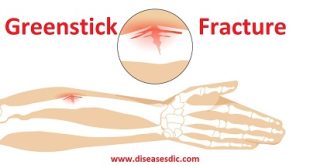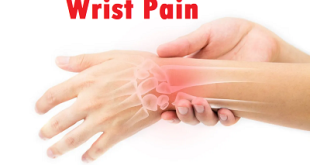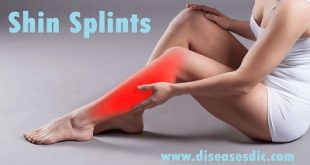Definition
Avascular necrosis (AVN) is the localized death of the bone due to injury, trauma, disease or drug side effects. Necrosis generally mean for cell death. Lack of blood flow to the bone cells causes bone necrosis and lead to complete bone damage. This often happens to bone due to injury, which interrupts the blood flow to the bone. In an extreme case of AVN, it can result to collapse of particular segments of bone. When AVN affects the joints, it may rapidly develop to osteoarthritis especially in hip, knee, spine, shoulder and wrist joints.
Avascular necrosis is also called as follows
- Osteonecrosis
- Aseptic necrosis
- Ischemic bone necrosis
- Bone infarction
Stages of AVN
|
Stages |
Clinical manifestation |
|
0 |
Asymptomatic, normal radiography findings and histology point outs osteonecrosis |
|
1 |
Wedged, mottled bone surface (sclerosis), core decompression, osteopenia. Abnormal histology and radiology findings. |
|
2 |
Crescent-shaped subchondral fracture, |
|
3 |
Femoral head fails mechanically with trabecular collapse |
|
4 |
Flattening of femoral head and collapsing of joints |
|
5 |
A decrease in joint space. A degenerative change extends to glenoid. |
Stages of Avascular necrosis (AVN).
Pathophysiology
Necrosis alone does not stand as a reason for AVN, but a restorative component of the bone repair process causes subchondral fracture and loss of structural integrity. The common pathophysiological pathway of AVN involves compromised subchondral microcirculation. Reduced blood flow to the femoral head can occur through three mechanisms:
- Fractures and dislocation make an interruption in vessels.
- The growth of thrombi or embolic fat in the blood vessels.
- Intraosseous extravascular compression from lipocyte hypertrophy or Gaucher cells
Epidemiology
- Approximately 10,000 – 20,000 cases are identified every year in the United States.
- The traumatic form of AVN occurs in 10% of undisplaced femoral neck fractures, 15-30% of displaced femoral neck fractures, and 10% of total hip dislocations.
- Corticosteroid consumption is to the non-traumatic form of osteonecrosis in 5-25% of patients. The male-to-female ratio is about 4:1. About 50% of patients were thought to have bilateral involvement of non-traumatic hip osteonecrosis
Risk factors of avascular necrosis
- Cigarette smoking
- Pregnancy
- Radiation and chemotherapy treatments
- Bone marrow and blood diseases such as sickle cell disease, Gaucher’s disease, thalassemia
- Underwater diver’s disease
- Systemic lupus erythematosus
- Diabetes mellitus
- Vasculitis
- Inflammatory bowel disease
- Childhood diseases including Legg-Calve Perthes disease
- Viral infections
- Femoral head dislocation
- Metastatic carcinoma
- Acute promyelocytic or lymphoid leukemia
What causes AVN?
- Dislocation or fracture of the femur bone (thigh bone). It is a type of injury which affects the blood flow to the bones eventually lead to trauma raised avascular necrosis.
- Long-term utilize of corticosteroids. Chronic use of these inflammation-fighting drugs such as prednisone and prednisolone, cause non-traumatic AVN. These drug molecules accumulate in the blood vessels makes narrowed vessels and gradually reduces the blood flow.
- Excessive alcohol consumption. Similar to corticosteroids, alcohol makes some fatty substances to accumulate in the blood vessels and reduces the blood supply to the bone.
- A sudden blood clot, damage, and inflammation to the arteries chunk the blood flow into the bone.
- Bisphosphonate use. Consumption of medications to increase the bone density for a long-term is the major risk factor for the jaw bone necrosis.
- Radiation therapy. Radiation therapy for cancer may affect the healthy cells and may cause injury to the surrounding blood vessels.
- Organ transplantation. Kidney transplants also a cause AVN.
Other non-traumatic conditions that cause AVN are as follows
- Sickle cell disease
- Pancreatitis, inflammation of the pancreas
- Gaucher’s disease,
- HIV infection
- Autoimmune diseases
Symptoms
In the early stages of avascular necrosis doesn’t cause any symptoms and later after it becomes worse it shows symptoms such as follows:
- Pain in the affected bone
- Pain when the hip bone bear the body weight
- Pain while walking and sitting
- If the hip bone is affected, pain commonly occurs in groin, buttocks, and thigh. It may spread to the knee joints
- Sometimes symptoms appear bilaterally that is pain may occur in both the joints in the hip.
Complications of avascular necrosis
Some of the complications of AVN include:
- Trauma
- Blood vessel damage
- Poor circulation
- Abnormal thick blood
- Inflammation of wall of blood vessels
- AVN may also cause osteoarthritis and pathologic fracture
- Collapse of femoral head in bone joints
Diagnosis and test
The primary diagnosis is a physical exam. Your doctor will do external physical exam by moving the joints that have pain. Some of the imaging tests for diagnosing the AVN are as follows:
MRI and CT scan: These scans produce an image of affected bones. It gives detailed information about the changes that happen to the bone and it may indicate AVN
X-Ray: in the early staged of AVN the X-Ray images show normal appearance of bone and later in the stages it shows some bone changes that reveals the AVN
Bone scan: The bright spot images are obtained and diagnosed for the AVN. The small amount of radioactive material is injected into your veins and this travel to the bones that are injured and shows the bright spots of the affected area on the bone.
Treatment of avascular necrosis
Non-surgical treatment
- Patients can walk by providing walker or stick or crutches
- In some cases, the surgeons prescribe biophysical treatments such as electric shock treatment and electrical simulation is attempted to get the bone to heal
- Keep the weight off the sore side foot while standing and walking
Surgical treatment
The surgical treatment may vary based on the age, cause of AVN and how much damage occurred to the bone. Some of the recommended surgeries are as follows:
Joint replacement: If the bone is collapsed and other treatment for AVN doesn’t work, then you might undergo for surgery to replace the damaged bone in the joints with the metal parts or any other plastic materials.
Bone transplant: If the bone is totally damaged then it can be transplanted with other bone graft from another part of your body. The graft is the healthy section of bone from other parts of your body.
Bone reshaping (Osteotomy): In this type of surgery, the wedge of the bone is removed above or below a weight-bearing joint, to help shift your weight off the damaged bone. Bone reshaping might allow you to postpone joint replacement.
Osteotomy
Core decompression: Core decompression is done by drilling small holes from the healthy bone to the area of necrosis in the humeral head. This creates channels that allow new blood vessels to grow into the necrotic area.
Regenerative treatment: The novel procedure is aspiration and concentration of bone is the future idea to overcome the AVN of the hip. The stem cells are harvested and inserted deep into the place where potentially allow the growth of new bone.
Bone aspiration
Medications
Some of the medications that reduce pain and complications of AVN includes
- Nonsteroidal anti-inflammatory drugs such as ibuprofen (Advil, Motrin IB, others) or naproxen sodium (Aleve, others) may help relieve the pain and inflammation associated with avascular necrosis
- Alendronate (Fosamax, Binosto), can be used for slow progression of AVN
- Warfarin (Coumadin, Jantoven) is used to prevent blood clot in blood vessels
Prevention of avascular necrosis
Some of the following steps that prevent the risk of developing AVN such as follows:
- Use low effect dose of systemic corticosteroids and if possible use steroid-sparing agent
- Maintain your cholesterol level low
- Limit heavy drinking alcohols
- Quit smoking
- Do early diagnosis and treatment if you feel pain in the bone joints
 Diseases Treatments Dictionary This is complete solution to read all diseases treatments Which covers Prevention, Causes, Symptoms, Medical Terms, Drugs, Prescription, Natural Remedies with cures and Treatments. Most of the common diseases were listed in names, split with categories.
Diseases Treatments Dictionary This is complete solution to read all diseases treatments Which covers Prevention, Causes, Symptoms, Medical Terms, Drugs, Prescription, Natural Remedies with cures and Treatments. Most of the common diseases were listed in names, split with categories.








I have been diagnosed with degenerative right pelvis bone and it hurts at my hip and down my right thigh.A few months ago I got a shot in my right hip and then I got real sick and I went to the hospital and they found out that part of my large intestine was dead they said I had thrown a blood clot and I was lucky to still be alive. Thanks to my guardian angel.
I feel severe pain in my left side of waist, there is small crack and my nerves has shift to this crack which course free flow of fluid to my down part finding difficult in walking.
Please consult a doctor as soon as possible.
use of simple language is help to understand for non medical persons also. thanks
is there any physical therapy useful in AVN